Hoffman D.M., Singh B., Thomas J.H. (Eds). Handbook of Vacuum Science and Technology
Подождите немного. Документ загружается.

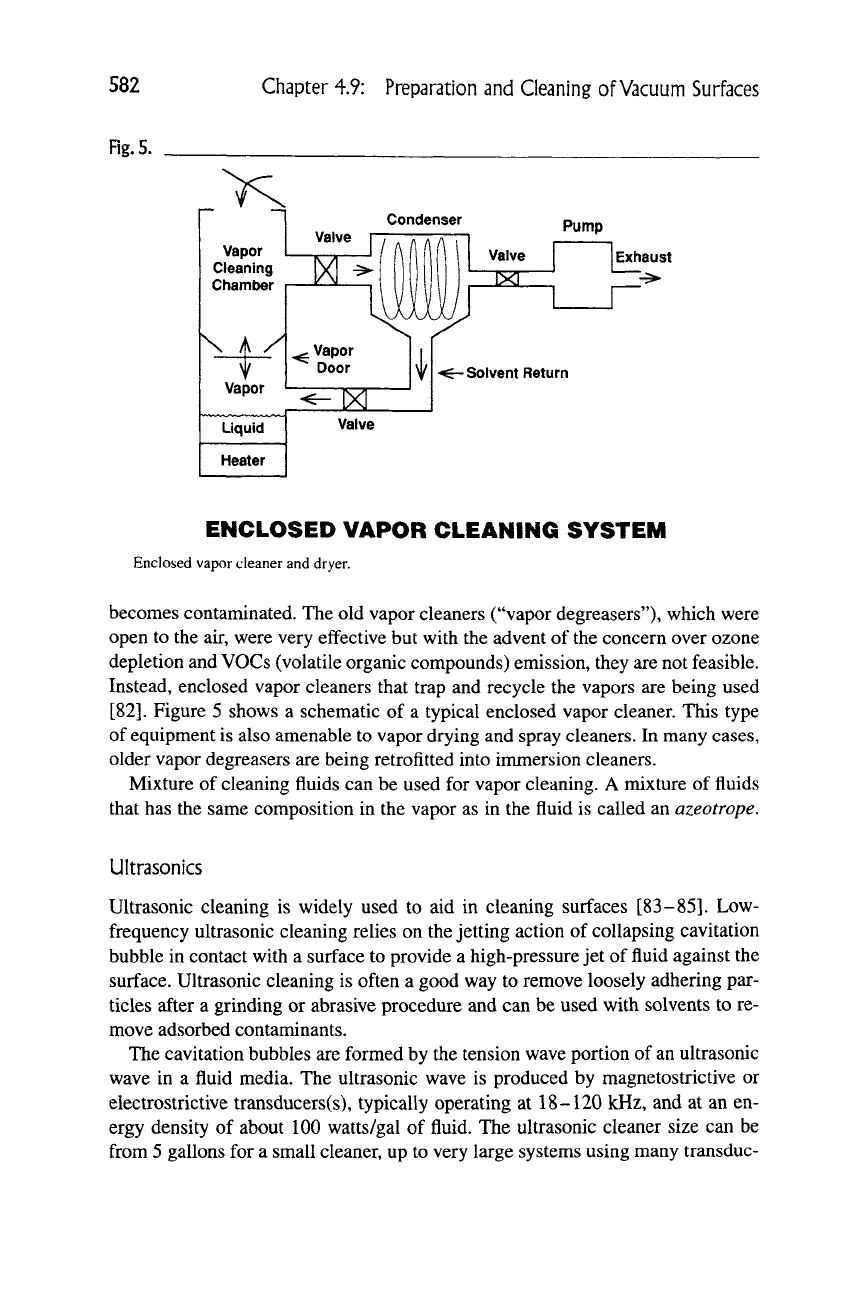
582
Chapter 4.9: Preparation and Cleaning of Vacuum Surfaces
Rg.5.
Pump
Valve
M
1
Exhaust
-^
1 r
Solvent Return
ENCLOSED VAPOR CLEANING SYSTEM
Enclosed vapor cleaner and dryer.
becomes contaminated. The old vapor cleaners ("vapor degreasers"), which were
open to the air, were very effective but with the advent of the concern over ozone
depletion and VOCs (volatile organic compounds) emission, they are not feasible.
Instead, enclosed vapor cleaners that trap and recycle the vapors are being used
[82].
Figure 5 shows a schematic of a typical enclosed vapor cleaner. This type
of equipment is also amenable to vapor drying and spray cleaners. In many cases,
older vapor degreasers are being retrofitted into immersion cleaners.
Mixture of cleaning fluids can be used for vapor cleaning. A mixture of fluids
that has the same composition in the vapor as in the fluid is called an azeotrope.
Ultrasonics
Ultrasonic cleaning is widely used to aid in cleaning surfaces [83-85]. Low-
frequency ultrasonic cleaning relies on the jetting action of collapsing cavitation
bubble in contact with a surface to provide a high-pressure jet of fluid against the
surface. Ultrasonic cleaning is often a good way to remove loosely adhering par-
ticles after a grinding or abrasive procedure and can be used with solvents to re-
move adsorbed contaminants.
The cavitation bubbles are formed by the tension wave portion of an ultrasonic
wave in a fluid media. The ultrasonic wave is produced by magnetostrictive or
electrostrictive transducers(s), typically operating at 18-120 kHz, and at an en-
ergy density of about 100 watts/gal of fluid. The ultrasonic cleaner size can be
from 5 gallons for a small cleaner, up to very large systems using many transduc-

4.9.2 External Cleaning 583
ers.
The size of cavitation bubbles in the fluid depends on the vapor pressure, sur-
face energy, and temperature of the fluid. For example, water at 60°C and 40 kHz
has a cavitation bubble size of about 3 microns. The jet pressure from the col-
lapsing bubble can be as high as 300 psi. The cavitation jetting is more energetic
for cooler media and when there are no gases in the bubble to hinder its collapse.
The ultrasonic energy density decreases with distance from the transducer; there-
fore the cavitation energy is greatest near the transducer surface. Acoustic stream-
ing results in an overall movement of fluid away from the transducer surface (bot-
tom of the tank). This brings contaminants that have settled to the bottom of the
tank up into the cleaning region. Therefore the cavitating fluid should be continu-
ously filtered.
When using a fixed-frequency transducer, there are nodes and antinodes formed
(standing waves) in the fluid, which produce variations of cavitation energy with
position. These standing wave patterns can be modified by reflection of the pres-
sure waves from surfaces in the tank. This variation in cavitation with position
can be overcome somewhat using swept-frequency generation. A typical system
uses 40 kHz ±2 kHz. If frequency sweeping is not used or there are large varia-
tions of cavitation energy with position, the parts should be moved from one re-
gion to another in the tank during cleaning. The ultrasonic frequencies are above
the hearing range of the human ear, and the audible noise that is heard from an ul-
trasonic cleaner is due to vibration of surfaces in the cleaner.
Variables in ultrasonic cleaning include [86,87]:
• Amplitude and frequency of pressure wave (energy density, standing wave
pattern)
• Nature of the transducer fluid (density, viscosity, surface tension, vapor
pressure)
• Nature of the cleaning fluid if different from the transducer media
• Surfaces in the transducer media that must transmit the pressure waves
• Row and filtering of the cleaner fluid
• Temperature of fluid
• Fluid contaminants such as water
• Gas content of the fluid
• Energy of cavitation implosion (temperature, pulse height of ultrasonic wave)
• Cavitation density changes with position in tank
• Cavitation density changes with time
• Shape of the pressure pulse
• Nature of ultrasonic cycle train ("quiet time," "degas time," cycles per train)
• Geometry of the system and associated fixtures
Quite often ultrasonic cleaning is not as effective as one would like. Ultrasonic
erosion or deformation of aluminum foil or removal of an aluminum metalliza-
tion from a glass surface can be used to determine the cavitation power that a sur-
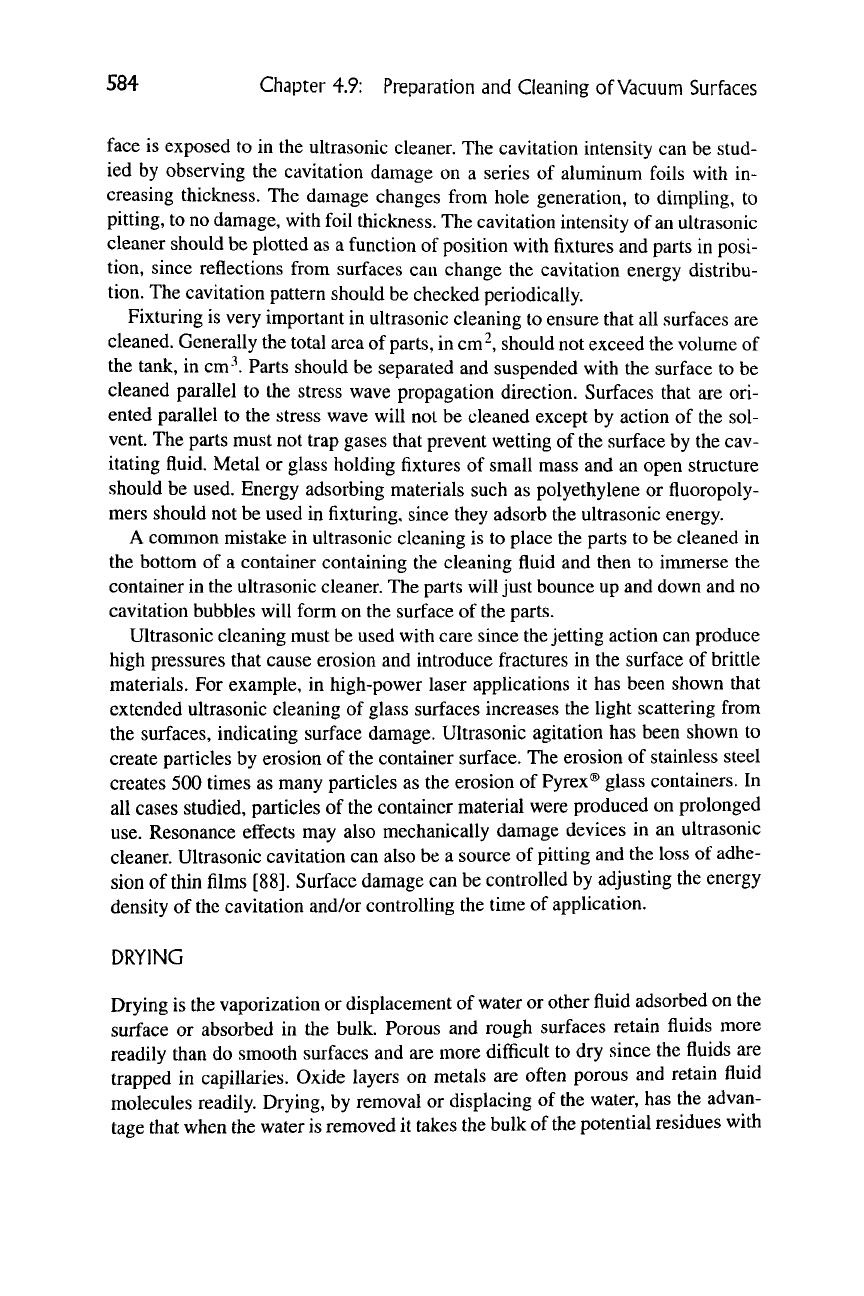
584 Chapter 4.9: Preparation and Cleaning of Vacuum Surfaces
face is exposed to in the ultrasonic cleaner. The cavitation intensity can be stud-
ied by observing the cavitation damage on a series of aluminum foils with in-
creasing thickness. The damage changes from hole generation, to dimpling, to
pitting, to no damage, with foil thickness. The cavitation intensity of
an
ultrasonic
cleaner should be plotted as a function of position with fixtures and parts in posi-
tion, since reflections from surfaces can change the cavitation energy distribu-
tion. The cavitation pattern should be checked periodically.
Fixturing is very important in ultrasonic cleaning to ensure that all surfaces are
cleaned. Generally the total area of
parts,
in
cm-^,
should not exceed the volume of
the tank, in cm-^. Parts should be separated and suspended with the surface to be
cleaned parallel to the stress wave propagation direction. Surfaces that are ori-
ented parallel to the stress wave will not be cleaned except by action of the sol-
vent. The parts must not trap gases that prevent wetting of the surface by the cav-
itating fluid. Metal or glass holding fixtures of small mass and an open structure
should be used. Energy adsorbing materials such as polyethylene or fluoropoly-
mers should not be used in fixturing, since they adsorb the ultrasonic energy.
A common mistake in ultrasonic cleaning is to place the parts to be cleaned in
the bottom of a container containing the cleaning fluid and then to immerse the
container in the ultrasonic cleaner. The parts will just bounce up and down and no
cavitation bubbles will form on the surface of the parts.
Ultrasonic cleaning must be used with caie since
the
jetting action can produce
high pressures that cause erosion and introduce fractures in the surface of brittle
materials. For example, in high-power laser applications it has been shown that
extended ultrasonic cleaning of glass surfaces increases the light scattering from
the surfaces, indicating surface damage. Ultrasonic agitation has been shown to
create particles by erosion of the container surface. The erosion of stainless steel
creates 500 times as many particles as the erosion of Pyrex® glass containers. In
all cases studied, particles of the container material were produced on prolonged
use.
Resonance effects may also mechanically damage devices in an ultrasonic
cleaner. Ultrasonic cavitation can also be a source of pitting and the loss of adhe-
sion of thin films [88]. Surface damage can be controlled by adjusting the energy
density of the cavitation and/or controlling the time of application.
DRYING
Drying is the vaporization or displacement of water or other fluid adsorbed on the
surface or absorbed in the bulk. Porous and rough surfaces retain fluids more
readily than do smooth surfaces and are more difficult to dry since the fluids are
trapped in capillaries. Oxide layers on metals are often porous and retain fluid
molecules readily. Drying, by removal or displacing of the water, has the advan-
tage that when the water is removed it takes the bulk of the potential residues with
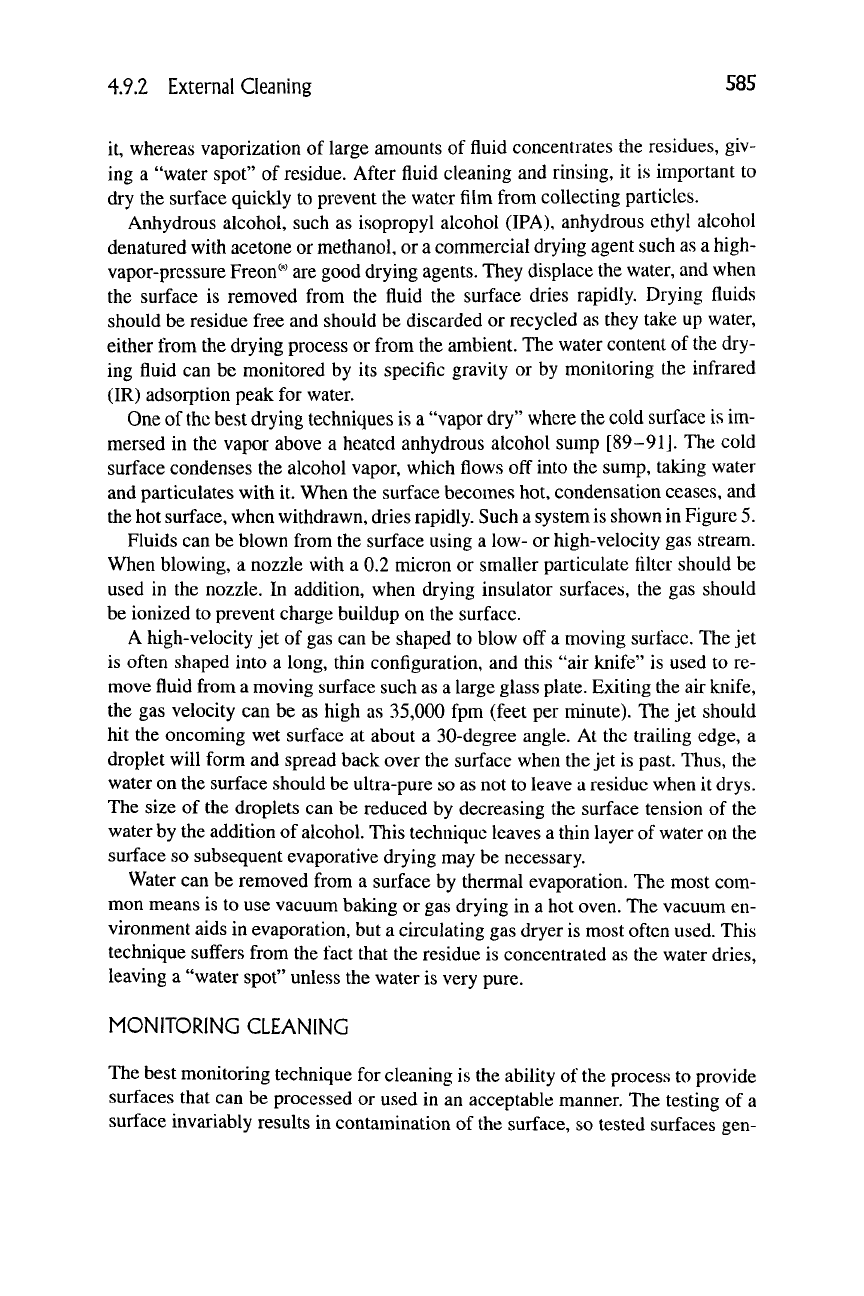
4.9.2 External Cleaning 585
it, whereas vaporization of large amounts of fluid concentrates the residues, giv-
ing a "water spot" of residue. After fluid cleaning and rinsing, it is important to
dry the surface quickly to prevent the water film from collecting particles.
Anhydrous alcohol, such as isopropyl alcohol (IPA), anhydrous ethyl alcohol
denatured with acetone or methanol, or a commercial drying agent such as a high-
vapor-pressure Freon^'^ are good drying agents. They displace the water, and when
the surface is removed from the fluid the surface dries rapidly. Drying fluids
should be residue free and should be discarded or recycled as they take up water,
either from the drying process or from the ambient. The water content of the dry-
ing fluid can be monitored by its specific gravity or by monitoring the infrared
(IR) adsorption peak for water.
One of
the
best drying techniques is a "vapor dry" where the cold surface is im-
mersed in the vapor above a heated anhydrous alcohol sump [89-91J. The cold
surface condenses the alcohol vapor, which flows off into the sump, taking water
and particulates with it. When the surface becomes hot, condensation ceases, and
the hot surface, when withdrawn, dries rapidly. Such a system is shown in Figure 5.
Fluids can be blown from the surface using a low- or high-velocity gas stream.
When blowing, a nozzle with a 0.2 micron or smaller particulate filter should be
used in the nozzle. In addition, when drying insulator surfaces, the gas should
be ionized to prevent charge buildup on the surface.
A high-velocity jet of gas can be shaped to blow off a moving surface. The jet
is often shaped into a long, thin configuration, and this "air knife" is used to re-
move fluid from a moving surface such as a large glass plate. Exiting the air knife,
the gas velocity can be as high as 35,000 fpm (feet per minute). The jet should
hit the oncoming wet surface at about a 30-degree angle. At the trailing edge, a
droplet will form and spread back over the surface when the jet is past. Thus, the
water on the surface should be ultra-pure so as not to leave a residue when it drys.
The size of the droplets can be reduced by decreasing the surface tension of the
water by the addition of
alcohol.
This technique leaves a thin layer of water on the
surface so subsequent evaporative drying may be necessary.
Water can be removed from a surface by thermal evaporation. The most com-
mon means is to use vacuum baking or gas drying in a hot oven. The vacuum en-
vironment aids in evaporation, but a circulating gas dryer is most often used. This
technique suffers from the fact that the residue is concentrated as the water dries,
leaving a "water spot" unless the water is very pure.
MONITORING CLEANING
The best monitoring technique for cleaning is the ability of the process to provide
surfaces that can be processed or used in an acceptable manner. The testing of a
surface invariably results in contamination of the surface, so tested surfaces gen-
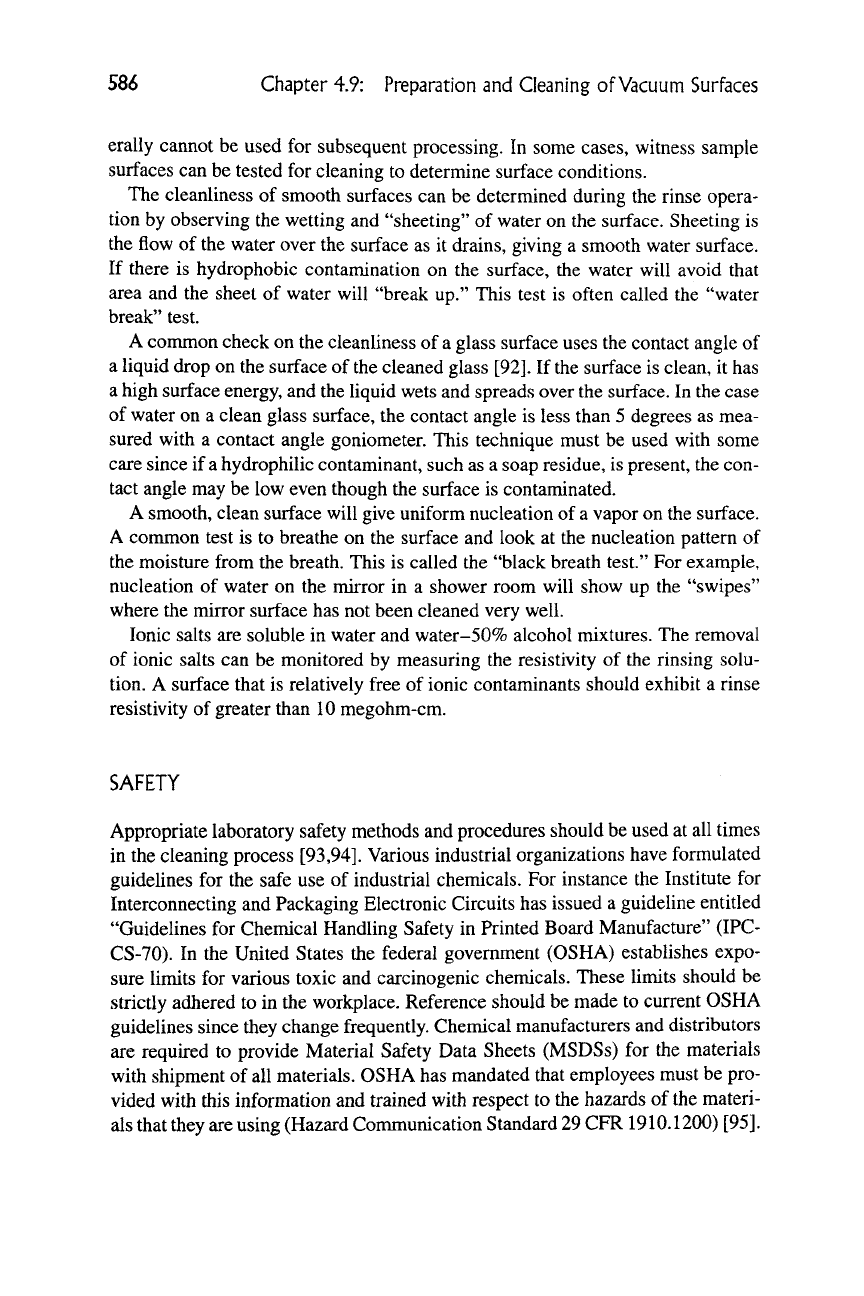
586 Chapter 4.9: Preparation and Cleaning of Vacuum Surfaces
erally cannot be used for subsequent processing. In some cases, witness sample
surfaces can be tested for cleaning to determine surface conditions.
The cleanliness of smooth surfaces can be determined during the rinse opera-
tion by observing the wetting and "sheeting" of water on the surface. Sheeting is
the flow of the water over the surface as it drains, giving a smooth water surface.
If there is hydrophobic contamination on the surface, the water will avoid that
area and the sheet of water will "break up." This test is often called the "water
break" test.
A common check on the cleanliness of a glass surface uses the contact angle of
a liquid drop on the surface of the cleaned glass [92]. If the surface is clean, it has
a high surface energy, and the liquid wets and spreads over the surface. In the case
of water on a clean glass surface, the contact angle is less than 5 degrees as mea-
sured with a contact angle goniometer. This technique must be used with some
care since if
a
hydrophilic contaminant, such as a soap residue, is present, the con-
tact angle may be low even though the surface is contaminated.
A smooth, clean surface will give uniform nucleation of a vapor on the surface.
A common test is to breathe on the surface and look at the nucleation pattern of
the moisture from the breath. This is called the "black breath test." For example,
nucleation of water on the miiror in a shower room will show up the "swipes"
where the mirror surface has not been cleaned very well.
Ionic salts are soluble in water and water-50% alcohol mixtures. The removal
of ionic salts can be monitored by measuring the resistivity of the rinsing solu-
tion. A surface that is relatively free of ionic contaminants should exhibit a rinse
resistivity of greater than 10 megohm-cm.
SAFETY
Appropriate laboratory safety methods and procedures should be used at all times
in the cleaning process [93,94]. Various industrial organizations have formulated
guidelines for the safe use of industrial chemicals. For instance the Institute for
Interconnecting and Packaging Electronic Circuits has issued a guideline entitled
"Guidelines for Chemical Handling Safety in Printed Board Manufacture" (IPC-
CS-70).
In the United States the federal government (OSHA) establishes expo-
sure limits for various toxic and carcinogenic chemicals. These limits should be
strictly adhered to in the workplace. Reference should be made to current OSHA
guidelines since they change frequendy. Chemical manufacturers and distributors
are required to provide Material Safety Data Sheets (MSDSs) for the materials
with shipment of all materials. OSHA has mandated that employees must be pro-
vided with this information and trained with respect to the hazards of the materi-
als that they are using (Hazard Communication Standard 29 CFR 1910.1200) [95].
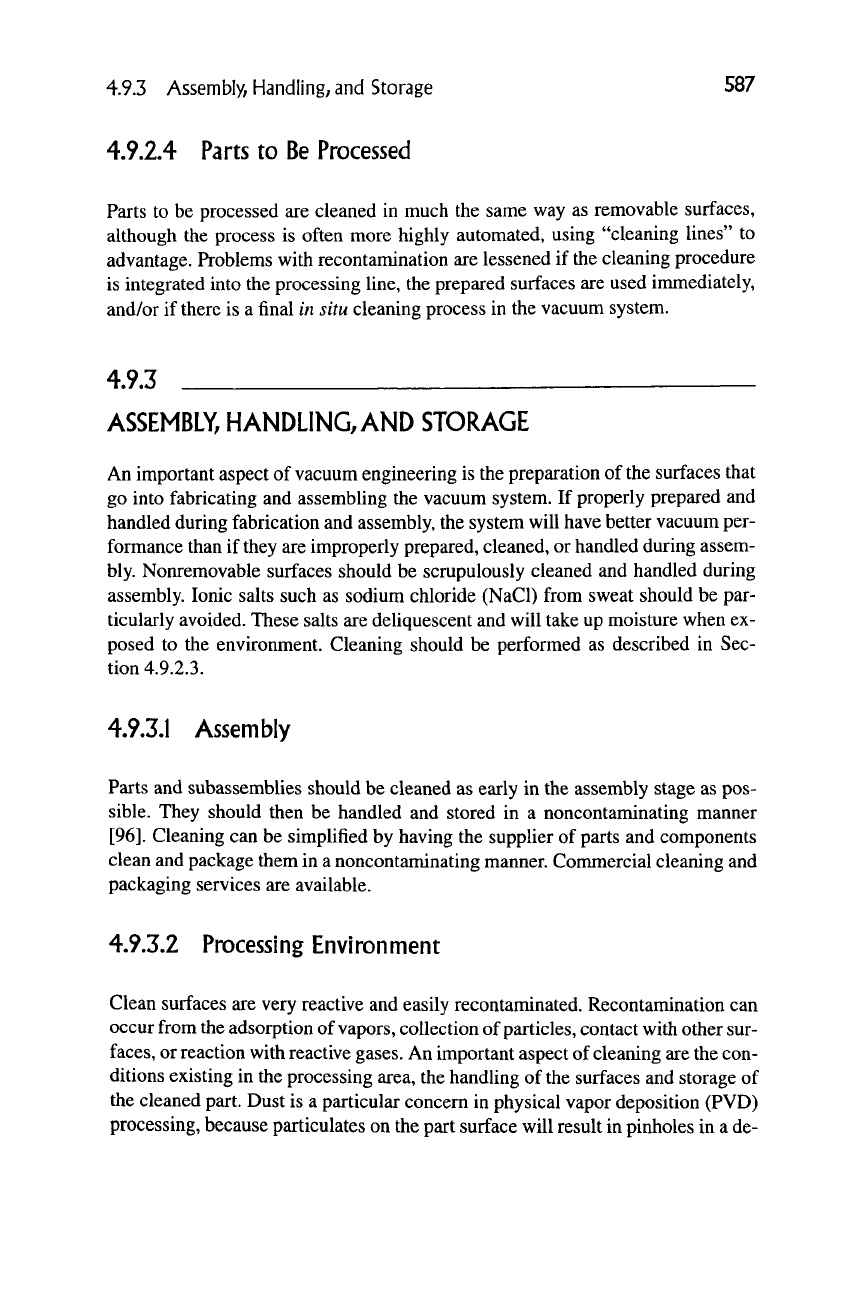
4.93 Assembly,
Handling,
and
Storage 587
4.9.2.4 Parts to Be Processed
Parts to be processed are cleaned in much the same way as removable surfaces,
although the process is often more highly automated, using "cleaning lines" to
advantage. Problems with recontamination are lessened if the cleaning procedure
is integrated into the processing line, the prepared surfaces are used immediately,
and/or if there is a final in situ cleaning process in the vacuum system.
4.9.3
ASSEMBLY, HANDLING, AND STORAGE
An important aspect of vacuum engineering is the preparation of the surfaces that
go into fabricating and assembling the vacuum system. If properly prepared and
handled during fabrication and assembly, the system will have better vacuum per-
formance than if they are improperly prepared, cleaned, or handled during assem-
bly. Nonremovable surfaces should be scrupulously cleaned and handled during
assembly. Ionic salts such as sodium chloride (NaCl) from sweat should be par-
ticularly avoided. These salts are deliquescent and will take up moisture when ex-
posed to the environment. Cleaning should be performed as described in Sec-
tion 4.9.2.3.
4.9.3.1 Assembly
Parts and subassemblies should be cleaned as early in the assembly stage as pos-
sible.
They should then be handled and stored in a noncontaminating manner
[96].
Cleaning can be simplified by having the supplier of parts and components
clean and package them in a noncontaminating manner. Conmiercial cleaning and
packaging services are available.
4.9.3.2 Processing Environment
Clean surfaces are very reactive and easily recontaminated. Recontamination can
occur from the adsorption of vapors, collection of particles, contact with other sur-
faces,
or reaction with reactive gases. An important aspect of cleaning are the con-
ditions existing in the processing area, the handling of the surfaces and storage of
the cleaned part. Dust is a particular concern in physical vapor deposition (PVD)
processing, because particulates on the part surface will result in pinholes in a de-
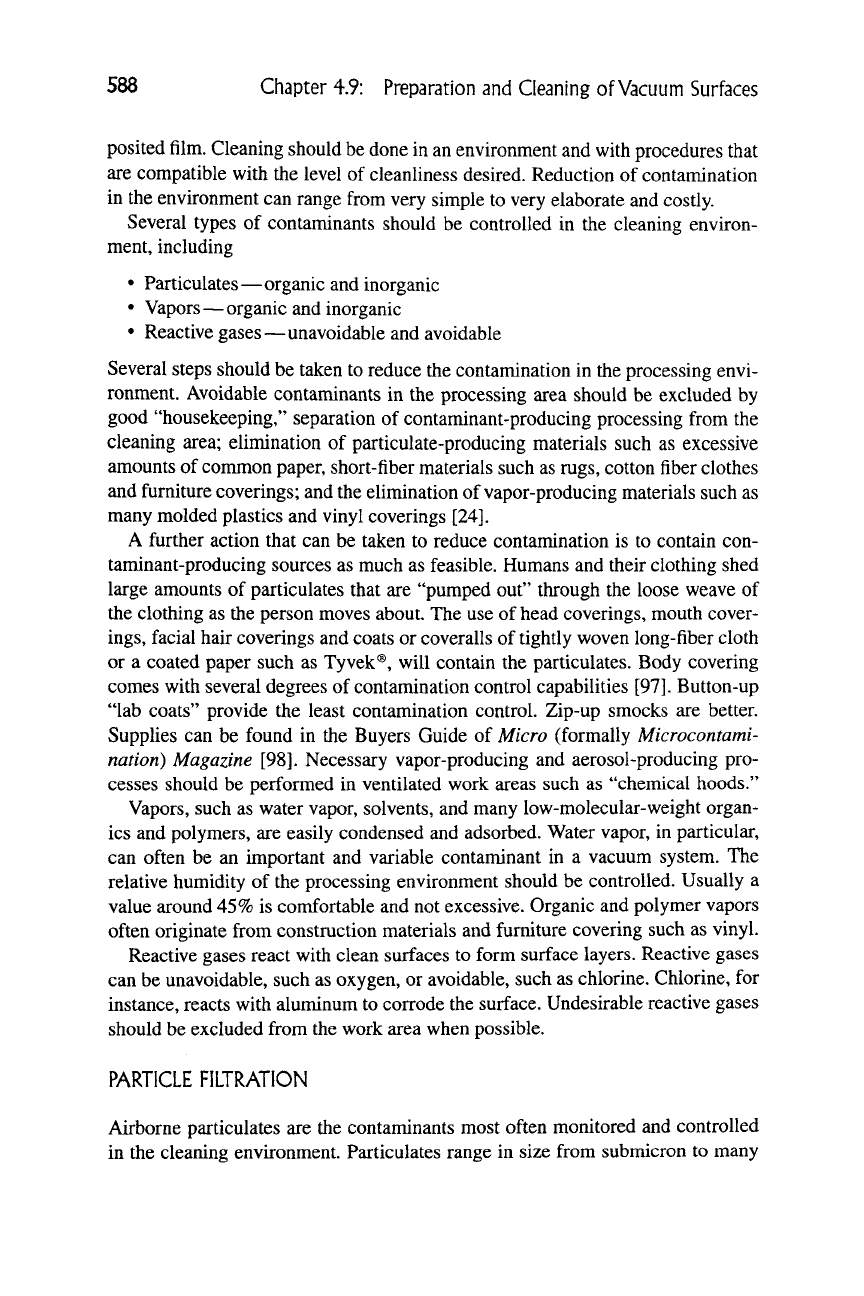
588 Chapter 4.9: Preparation
and
Cleaning of Vacuum Surfaces
posited film. Cleaning should be done in an environment and with procedures that
are compatible with the level of cleanliness desired. Reduction of contamination
in the environment can range from very simple to very elaborate and costly.
Several types of contaminants should be controlled in the cleaning environ-
ment, including
• Particulates—organic and inorganic
• Vapors—organic and inorganic
• Reactive gases — unavoidable and avoidable
Several steps should be taken to reduce the contamination in the processing envi-
ronment. Avoidable contaminants in the processing area should be excluded by
good "housekeeping," separation of contaminant-producing processing from the
cleaning area; elimination of particulate-producing materials such as excessive
amounts of common paper, short-fiber materials such as rugs, cotton fiber clothes
and furniture coverings; and the elimination of vapor-producing materials such as
many molded plastics and vinyl coverings [24].
A further action that can be taken to reduce contamination is to contain con-
taminant-producing sources as much as feasible. Humans and their clothing shed
large amounts of particulates that are "pumped out" through the loose weave of
the clothing as the person moves about. The use of head coverings, mouth cover-
ings,
facial hair coverings and coats or coveralls of tightly woven long-fiber cloth
or a coated paper such as Tyvek®, will contain the particulates. Body covering
comes with several degrees of contamination control capabilities [97]. Button-up
"lab coats" provide the least contamination control. Zip-up smocks are better.
Supplies can be found in the Buyers Guide of Micro (formally Microcontami-
nation) Magazine [98]. Necessary vapor-producing and aerosol-producing pro-
cesses should be performed in ventilated work areas such as "chemical hoods."
Vapors, such as water vapor, solvents, and many low-molecular-weight organ-
ics and polymers, are easily condensed and adsorbed. Water vapor, in particular,
can often be an important and variable contaminant in a vacuum system. The
relative humidity of the processing environment should be controlled. Usually a
value around
45%
is comfortable and not excessive. Organic and polymer vapors
often originate from construction materials and furniture covering such as vinyl.
Reactive gases react with clean surfaces to form surface layers. Reactive gases
can be unavoidable, such as oxygen, or avoidable, such as chlorine. Chlorine, for
instance, reacts with aluminum to corrode the surface. Undesirable reactive gases
should be excluded from the work area when possible.
PARTICLE FILTRATION
Airborne particulates are the contaminants most often monitored and controlled
in the cleaning environment. Particulates range in size from submicron to many

4.9.3 Assembly,
Handling,
and
Storage 589
microns and are measured by light scattering techniques and specified as to the
number of particles per cubic foot of air above a certain size (e.g., 0.5 microns).
The smaller and lighter the particle, the less its settling rate and the more easily it
can be stirred up to become airborne. The smallest particles are generally formed
by evaporation of aerosols such as sea spray and bodily fluids from talking and
sneezing. Such particles are often inorganic salts. Common organic particles
come from broken fabric fibers (wool or cotton) and skin sloughing.
Particulates are removed from the cleaning environment by mechanical filter-
ing [99-101]. Small processing areas with filtered air supplies can be used to pro-
vide local clean areas
[100].
These can be "clean benches," which use a horizon-
tal laminar flow of filtered air to remove particulates or "soft-wall" clean areas
that are separated from the processing area by plastic curtains and use downward
laminar flow of filtered air that enters at the ceiling and exits underneath the cur-
tain. The ultimate clean area is the "cleanroom." Cleanroom standards are mea-
sured by the number of particles per cubic foot of air with particle size greater
than 0.5 microns. Class 1 cleanrooms are attainable with very stringent design,
fabrication, and operating conditions. Class 100 cleanrooms are becoming com-
mon in fabrication and assembly of particulate-sensitive components and devices.
Class 10,000 rooms are usually attainable with modification of existing facilities
and moderate control of conditions in the room and are used as general cleaning
and assembly areas. Uncontrolled areas can be Class 100,000 or greater. The term
"cleanroom" is somewhat of a misnomer in that, in a cleanroom, no attempt is
made to filter vapors from the air. Efficient cleanrooms are very expensive to
build, operate, and maintain. Careful consideration should be given to other tech-
niques for contamination control before deciding that a high-class (really a low
Class) cleanroom is needed.
4.9.3.3 Handling
An integral, and often neglected, aspect of cleaning is that of handling and stor-
age before the next processing step or usage. Handling and storage after cleaning
is a major source of recontamination. If possible, parts should be held in fixtures
made of materials that can be easily cleaned and do not contain potentially con-
taminating materials such as the plasticizers on molded polymers. Glass, ceram-
ics,
hard metals, or unplasticized polymers are used as handling fixturing materi-
als.
It is best if
the
fixtures do not touch areas of
concern,
since "abrasive transfer"
of clean materials in contact can result in contamination. The use of cleaning fix-
tures reduces the amount of touching of the critical surfaces by the operator dur-
ing the cleaning process.
It is preferable to handle surfaces using fixtures or tools; however, in many
cases the surfaces must be handled directly, so gloves must be used. Gloves may
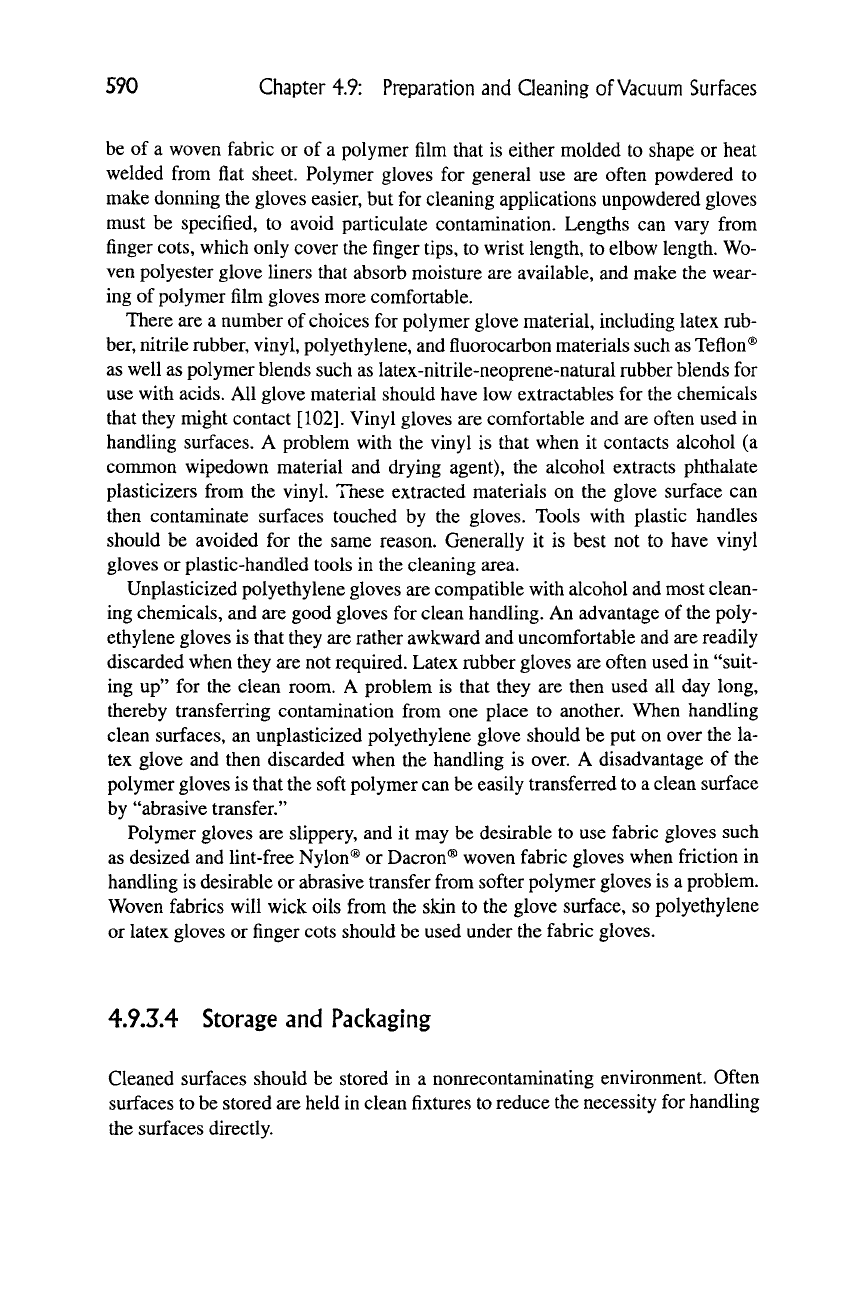
590 Chapter 4.9: Preparation and Cleaning of Vacuum Surfaces
be of a woven fabric or of a polymer film that is either molded to shape or heat
welded from flat sheet. Polymer gloves for general use are often powdered to
make donning the gloves easier, but for cleaning applications unpowdered gloves
must be specified, to avoid particulate contamination. Lengths can vary from
finger
cots,
which only cover the finger tips, to wrist length, to elbow length. Wo-
ven polyester glove liners that absorb moisture are available, and make the wear-
ing of polymer film gloves more comfortable.
There are a number of choices for polymer glove material, including latex rub-
ber, nitrile rubber, vinyl, polyethylene, and fluorocarbon materials such as Teflon®
as well as polymer blends such as latex-nitrile-neoprene-natural rubber blends for
use with acids. All glove material should have low extractables for the chemicals
that they might contact
[102].
Vinyl gloves are comfortable and are often used in
handling surfaces. A problem with the vinyl is that when it contacts alcohol (a
common wipedown material and drying agent), the alcohol extracts phthalate
plasticizers from the vinyl. These extracted materials on the glove surface can
then contaminate surfaces touched by the gloves. Tools with plastic handles
should be avoided for the same reason. Generally it is best not to have vinyl
gloves or plastic-handled tools in the cleaning area.
Unplasticized polyethylene gloves are compatible with alcohol and most clean-
ing chemicals, and are good gloves for clean handling. An advantage of the poly-
ethylene gloves is that they are rather awkward and uncomfortable and are readily
discarded when they are not required. Latex rubber gloves are often used in "suit-
ing up" for the clean room. A problem is that they are then used all day long,
thereby transferring contamination from one place to another. When handling
clean surfaces, an unplasticized polyethylene glove should be put on over the la-
tex glove and then discarded when the handling is over. A disadvantage of the
polymer gloves is that the soft polymer can be easily transferred to a clean surface
by "abrasive transfer."
Polymer gloves are slippery, and it may be desirable to use fabric gloves such
as desized and lint-free Nylon® or Dacron® woven fabric gloves when friction in
handling is desirable or abrasive transfer from softer polymer gloves is a problem.
Woven fabrics will wick oils from the skin to the glove surface, so polyethylene
or latex gloves or finger cots should be used under the fabric gloves.
4.9.3.4 Storage and Packaging
Cleaned surfaces should be stored in a nonrecontaminating environment. Often
surfaces to be stored are held in clean fixtures to reduce the necessity for handling
the surfaces directly.
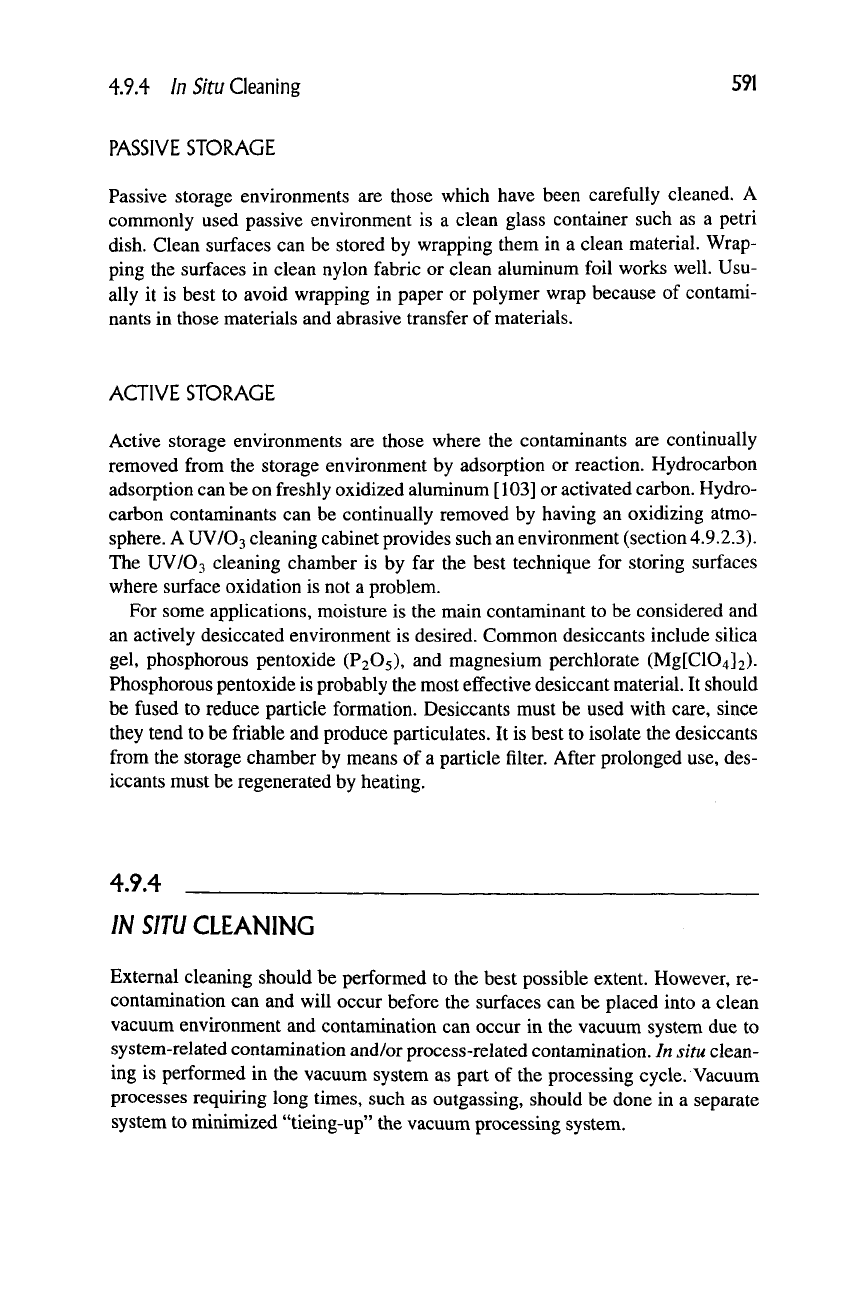
4.9.4 In
Situ
Cleaning 591
PASSIVE STORAGE
Passive storage environments are those which have been carefully cleaned. A
commonly used passive environment is a clean glass container such as a petri
dish. Clean surfaces can be stored by wrapping them in a clean material. Wrap-
ping the surfaces in clean nylon fabric or clean aluminum foil works well. Usu-
ally it is best to avoid wrapping in paper or polymer wrap because of contami-
nants in those materials and abrasive transfer of materials.
ACTIVE STORAGE
Active storage environments are those where the contaminants are continually
removed from the storage environment by adsorption or reaction. Hydrocarbon
adsorption can be on freshly oxidized aluminum [103] or activated carbon. Hydro-
carbon contaminants can be continually removed by having an oxidizing atmo-
sphere. A UV/O3 cleaning cabinet provides such an environment (section 4.9.2.3).
The UV/O3 cleaning chamber is by far the best technique for storing surfaces
where surface oxidation is not a problem.
For some applications, moisture is the main contaminant to be considered and
an actively desiccated environment is desired. Common desiccants include silica
gel,
phosphorous pentoxide (P2O5), and magnesium perchlorate (Mg[C104]2).
Phosphorous pentoxide is probably the most effective desiccant material. It should
be fused to reduce particle formation. Desiccants must be used with care, since
they tend to be friable and produce particulates. It is best to isolate the desiccants
from the storage chamber by means of a particle filter. After prolonged use, des-
iccants must be regenerated by heating.
4.9.4
/WS/rii CLEANING
External cleaning should be performed to the best possible extent. However, re-
contamination can and will occur before the surfaces can be placed into a clean
vacuum environment and contamination can occur in the vacuum system due to
system-related contamination and/or process-related contamination. In situ clean-
ing is performed in the vacuum system as part of the processing cycle. Vacuum
processes requiring long times, such as outgassing, should be done in a separate
system to minimized "tieing-up" the vacuum processing system.
